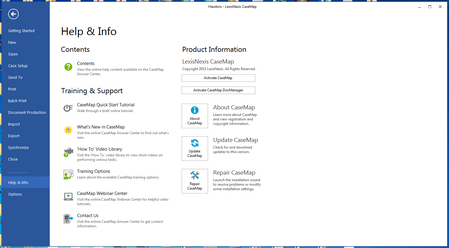About CaseMap menus
CaseMap's ribbons (a set of toolbars placed on multiple tabs) are located at the top of the CaseMap screen. Click on each ribbon (i.e., Reports) to access a set of controls/menus, each providing additional functionality or duplicate toolbar button functionality in CaseMap.
The commands on each tab/menu affect the spreadsheet currently in view. Some options will give you an arrow that opens a submenu of additional tools. Most of the menu commands also have corresponding keyboard shortcuts.
|
The Outline Tools tab is only accessible when the Issues spreadsheet has been selected, and the Linked Authority Tools tab is accessible when the Research Authorities and Extracts spreadsheet is opened. |
The File tab contains menu items useful to accessing your case, such as New, Open, Close, and Exit. The File tab also has options for importing data from other applications, exporting a text file of the case, changing case settings from the Case Setup page, sending spreadsheet records to LexisNexis® TimeMap, Sanction, NoteMap, Microsoft® Word, Corel® WordPerfect, or Excel, creating a replica and synchronizing data from a replica case with the master file. Learning CaseMap and printing options are also listed on this menu, and you can view case properties as well.
The File tab also provides access to the CaseMap Answer Center as well as a variety of other reference materials. From this tab (File Tab > Help & Info), you can also reference your CaseMap license and registration information, activate the software, check for Web updates of the software, learn more about CaseMap and other LexisNexis products. You can also run the maintenance program, Detect and Repair, from here too.
|
The Home ribbon contains menu items for editing and formatting text information within a spreadsheet record: Cut, Copy, Paste, Sort, Filter, Find, and Replace. You can also permanently delete a record from the case. The Home ribbon also allows you to quickly add a new record, a new question linked to a selected record, or object to a spreadsheet, run filters, sort the spreadsheet, and change the format and fields in the spreadsheet. You can also insert a copy of the record into the same spreadsheet. The command to insert a symbol, like a registered trademark, is available here too. Other tools allow you to view all available fields for a record by opening the Record Detail box and to open Linked Files for a record. The Home ribbon also provides you with Smart Assist capabilities that assists you in performing various tasks in CaseMap. SmartAssist allows you to search CaseMap by typing in a word/phrase, generate reports, and/or it also provides access to other links for additional information. |
The Reports ribbon contains all reporting options, including the ReportBooks submenu. From here you can access print/batch print options, to include Document Production features. You can export report data to other applications, and find wizards to assist in creating common reports, like the Privilege Log.
|
The Case Tools ribbon allows you to access primarily advanced user or administrative tools for working with or customizing cases, such as accessing the Case Optimizer, Case Index menu and Case Scripts menu, and the Create Case Template Wizard. The Case Tools ribbon contains a variety of tools used for analyzing and managing case data. It also provides you access to functions which allows you to perform bulk record and linked files updates for working with PDF files and other files and viewers.
|
The View ribbon contains commands that help modify the CaseMap user interface based on your viewing preference. You can choose to show/hide the Navigation pane and/or Task Panes (Issue Linking), to include accessing CaseWide which allows you to scroll, toggle, and drill-down for different perspectives of your case timeline. You can also access the Linked Authority split-screen view from the Authorities and Extracts spreadsheet. Use the Current View submenu to toggle to a different view of the spreadsheet or to access the Define Views dialog box for maintaining the views on spreadsheets.
The Object Display Options submenu allows you to change the display of short names/full names in your spreadsheet.
|
The Outline tools ribbon which is only accessible when the Issues spreadsheet is selected, and allows you to make adjustments to outline entries and to the number of outline levels displayed. |
The Linked Authority Tools ribbon which is only accessible when the Authorities and Extracts spreadsheet is selected, and allows you to create, delete, and/or view record details. You also have the ability to view linked files, print, and/or customize spreadsheet views. You can also toggle between the Extracts from Authorities and the Authorities and Extracts spreadsheets. This button displays only when working in these two spreadsheets.
|
The DocManager ribbon allows you to review and annotate documents and images without having to open the source file in its native application. You can add notes to annotations, edit annotations and notes, and also search annotation notes. When a search is run, search hits are highlighted in DocManager allowing you to review content and navigate between search hits. The DocManager also provides you with the ability to dock and undock documents and/or images in CaseMap using the Dock in Spreadsheet command.
|











